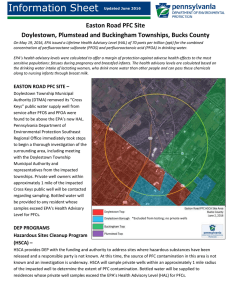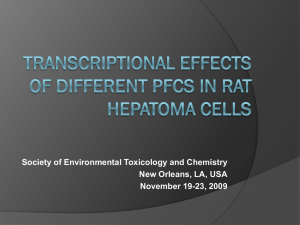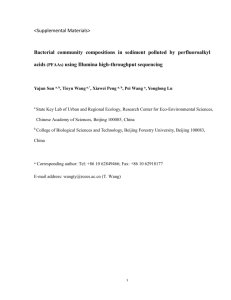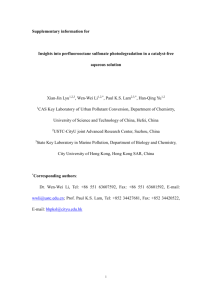Emerging Contaminants
advertisement
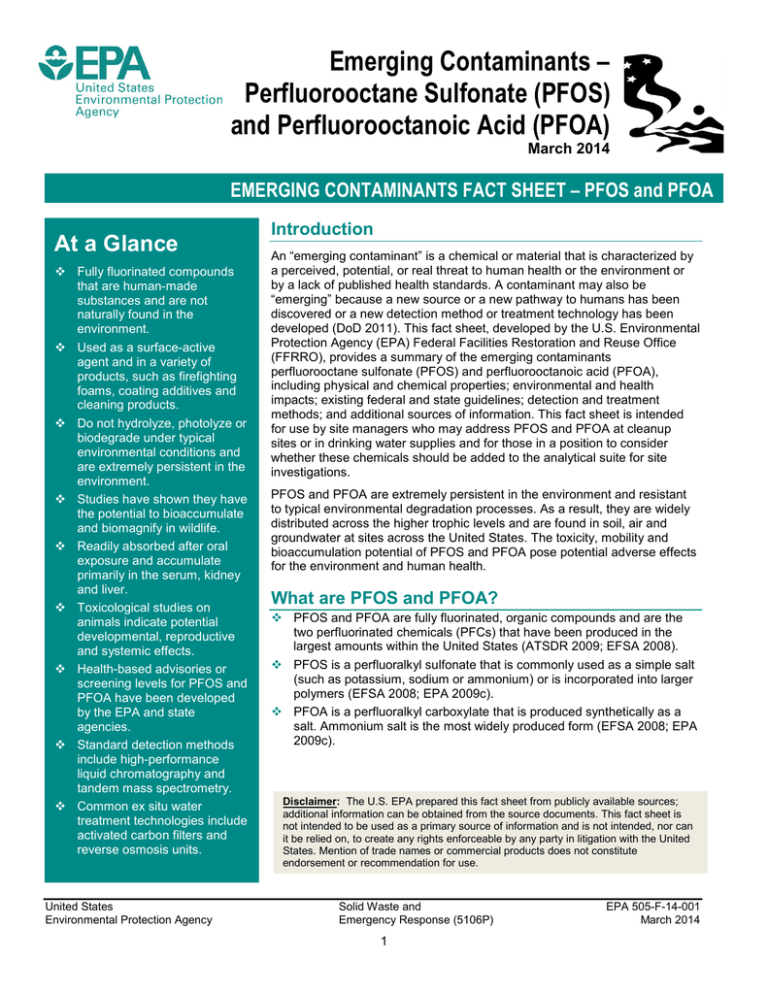
Emerging Contaminants – Perfluorooctane Sulfonate (PFOS) and Perfluorooctanoic Acid (PFOA) March 2014 EMERGING CONTAMINANTS FACT SHEET – PFOS and PFOA At a Glance Fully fluorinated compounds that are human-made substances and are not naturally found in the environment. Used as a surface-active agent and in a variety of products, such as firefighting foams, coating additives and cleaning products. Do not hydrolyze, photolyze or biodegrade under typical environmental conditions and are extremely persistent in the environment. Studies have shown they have the potential to bioaccumulate and biomagnify in wildlife. Readily absorbed after oral exposure and accumulate primarily in the serum, kidney and liver. Toxicological studies on animals indicate potential developmental, reproductive and systemic effects. Health-based advisories or screening levels for PFOS and PFOA have been developed by the EPA and state agencies. Standard detection methods include high-performance liquid chromatography and tandem mass spectrometry. Common ex situ water treatment technologies include activated carbon filters and reverse osmosis units. United States Environmental Protection Agency Introduction An “emerging contaminant” is a chemical or material that is characterized by a perceived, potential, or real threat to human health or the environment or by a lack of published health standards. A contaminant may also be “emerging” because a new source or a new pathway to humans has been discovered or a new detection method or treatment technology has been developed (DoD 2011). This fact sheet, developed by the U.S. Environmental Protection Agency (EPA) Federal Facilities Restoration and Reuse Office (FFRRO), provides a summary of the emerging contaminants perfluorooctane sulfonate (PFOS) and perfluorooctanoic acid (PFOA), including physical and chemical properties; environmental and health impacts; existing federal and state guidelines; detection and treatment methods; and additional sources of information. This fact sheet is intended for use by site managers who may address PFOS and PFOA at cleanup sites or in drinking water supplies and for those in a position to consider whether these chemicals should be added to the analytical suite for site investigations. PFOS and PFOA are extremely persistent in the environment and resistant to typical environmental degradation processes. As a result, they are widely distributed across the higher trophic levels and are found in soil, air and groundwater at sites across the United States. The toxicity, mobility and bioaccumulation potential of PFOS and PFOA pose potential adverse effects for the environment and human health. What are PFOS and PFOA? PFOS and PFOA are fully fluorinated, organic compounds and are the two perfluorinated chemicals (PFCs) that have been produced in the largest amounts within the United States (ATSDR 2009; EFSA 2008). PFOS is a perfluoralkyl sulfonate that is commonly used as a simple salt (such as potassium, sodium or ammonium) or is incorporated into larger polymers (EFSA 2008; EPA 2009c). PFOA is a perfluoralkyl carboxylate that is produced synthetically as a salt. Ammonium salt is the most widely produced form (EFSA 2008; EPA 2009c). Disclaimer: The U.S. EPA prepared this fact sheet from publicly available sources; additional information can be obtained from the source documents. This fact sheet is not intended to be used as a primary source of information and is not intended, nor can it be relied on, to create any rights enforceable by any party in litigation with the United States. Mention of trade names or commercial products does not constitute endorsement or recommendation for use. Solid Waste and Emergency Response (5106P) 1 EPA 505-F-14-001 March 2014 Emerging Contaminants Fact Sheet – PFOS and PFOA What are PFOS and PFOA? (continued) PFOS synonyms include 1-octanesulfonic acid, heptadecafluoro-, 1-perfluorooctanesulfonic acid, heptadecafluoro-1-octanesulfonic acid, perfluoron-octanesulfonic acid, perfluoroctanesulfonic acid and perfluoroctylsulfonic acid (ATSDR 2009; UNEP 2005). PFOA synonyms include pentadecafluoro1octanoic acid, pentadecafluoro-n-octanoic acid, pentadecaflurooctanoic acid, perfluorocaprylic acid, perfluoroctanoic acid, perfluoroheptanecarboxylic acid and octanoic acid (ATSDR 2009). They are stable chemicals that include long carbon chains. Because of their unique lipid- and water-repellent characteristics, PFOS and PFOA are used as surface-active agents in various hightemperature applications and as a coating on surfaces that contact with strong acids or bases (Schultz and others 2003; UNEP 2005). PFCs are used in a wide variety of industrial and commercial products such as textiles and leather products, metal plating, the photographic industry, photolithography, semi-conductors, paper and packaging, coating additives, cleaning products and pesticides (ATSDR 2009; EPA 2009c; OECD 2002). Through 2001, PFCs were used to manufacture Aqueous Film Forming Foam (AFFF). PFOSbased AFFF is used to extinguish flammable liquid fires (for example, hydrocarbon fueled), such as fires involving gas tankers and oil refineries (EPA 2013a; DoD SERDP 2012). They are human-made compounds and do not occur naturally in the environment (ATSDR 2009; EPA 2009c). PFOS and PFOA can also be formed by environmental microbial degradation or by metabolism in larger organisms from a large group of related substances or precursor compounds (ATSDR 2009; UNEP 2006). The 3M Company, the primary manufacturer of PFOS, completed a voluntary phase-out of PFOS production in 2002 (ATSDR 2009; 3M 2008). Exhibit 1: Physical and Chemical Properties of PFOS and PFOA (ATSDR 2009; Brooke and others 2004; EFSA 2008; Environment Canada 2012; EPA 2002b; OECD 2002; UNEP 2006) Property PFOS (Potassium Salt) PFOA (Free Acid) Chemical Abstracts Service (CAS) Number Physical Description (physical state at room temperature and atmospheric pressure) Molecular weight (g/mol) 2795-39-3 335-67-1 White powder/ waxy white solid 414 o Water solubility at 25 C (mg/L) o Melting Point ( C) o Boiling point ( C) o Vapor pressure at 20 C (mm Hg) Octanol-water partition coefficient (log Kow) Organic-carbon partition coefficient (log Koc) 3 Henry’s law constant (atm-m /mol) Half-Life White powder 538 550 to 570 (purified), 370 (fresh water), 25 (filtered sea water) > 400 Not measurable -6 2.48 X10 Not measurable 2.57 (Value estimated based on anion and not the salt) -9 3.05 × 10 Atmospheric: 114 days Water: > 41 years (at 25º C) o 3 9.5 X 10 (purified) 45 to 54 188 to 192 1 0.017 Not measurable 2.06 Not measurable 2 Atmospheric: 90 days Water: > 92 years (at 25º C) Abbreviations: g/mol – grams per mole; mg/L – milligrams per liter; C – degree Celsius; mm Hg – millimeters of mercury; 3 atm-m /mol – atmosphere-cubic meters per mole. 1 Extrapolation from measurement. 2 The atmospheric half-life value identified for PFOA is estimated based on available data determined from short study periods. 2 Emerging Contaminants Fact Sheet – PFOS and PFOA What are PFOS and PFOA? (continued) industrial components) such as electrical wire casings, fire- and chemical-resistant tubing and plumbing seal tape. They are also produced unintentionally by the degradation of some fluorotelomers (ATSDR 2009; EPA 2009c). As part of the EPA’s PFOA stewardship program, eight companies committed to achieve the following by 2010: (1) reduce global facility emissions of PFOA to all media; (2) reduce precursor chemicals that break down to PFOA and related higher homologue chemicals; and (3) PFOA product content (95 percent). The companies also agreed to work toward eliminating these chemicals from emissions and products by 2015 (EPA 2013a). PFOS chemicals are no longer manufactured in the United States; however, EPA significant new use rules (SNURs) allow for the continuation of a few, limited, highly technical applications of PFOSrelated substances where no known alternatives are available. In addition, existing stocks of PFCbased chemicals that were manufactured or imported into the United States before the effective date of the SNURs (for example, PFOSbased AFFF produced before the rules took effect in 2002) can still be used (EPA 2009c, 2013a). PFOA as its ammonium salt is manufactured primarily for use as an aqueous dispersion agent and in the manufacture of fluoropolymers (which are used in a wide variety of mechanical and What are the environmental impacts of PFOS and PFOA? During past manufacturing processes, large amounts of PFOS and PFOA were released to the air, water and soil in and around fluorochemical facilities (ATSDR 2009). PFOS and PFOA have been detected in a number of U.S. cities in surface water and sediments downstream of former fluorochemical production facilities and in wastewater treatment plant effluent, sewage sludge and landfill leachate (EPA 2002b; OECD 2002). The environmental release of PFOS-based AFFF may also occur from tank and supply line leaks, use of aircraft hangar fire suppression systems and firefighting training (DoD SERDP 2012). Both PFOS and PFOA are the stable end products resulting from the degradation of precursor substances through a variety of abiotic and biotic transformation pathways (Conder and others 2010). Because of their chemical structure, PFCs, including PFOS and PFOA, are chemically and biologically stable in the environment and resist typical environmental degradation processes, including atmospheric photooxidation, direct photolysis and hydrolysis. As a result, these chemicals are extremely persistent in the environment (OECD 2002; Schultz and others 2003). PFOS and PFOA have very low volatility because of their ionic nature. Therefore, they will be 3 persistent in water and soil (3M 2000; ATSDR 2009). When released directly to the atmosphere, PFCs are expected to adsorb to particles and settle to the ground through wet or dry deposition (Barton and others 2007; Hurley and others 2004). In their anionic forms, PFOA and PFOS are watersoluble and can migrate readily from soil to groundwater, where they can be transported long distances (Davis and others 2007; Post and others 2012). Monitoring data from the Arctic region and at sites remote from known point sources have shown levels of PFOS and PFOA in environmental media and biota, indicating that long-range transport has occurred. For example, PFOA and PFOS have been detected in concentrations from the low- to mid- picograms per liter (pg/L) range in remote regions of the Arctic caps. In addition, PFOS concentrations detected in the liver of the Canadian Arctic polar bear range from 1,700 to more than 4,000 nanograms per gram (ng/g) (Lau and others 2007; Martin and others 2004; Young and others 2007). Causes of long-range PFC transport include (1) atmospheric transport of precursor compounds (such as perfluoroalkyl sulfonamides), followed by degradation to form PFCs and (2) direct, longrange transport of PFCs via ocean currents or in the form of marine aerosols (Armitage and others 2006; Post and others 2012). Emerging Contaminants Fact Sheet – PFOS and PFOA What are the environmental impacts of PFOS and PFOA? (continued) The wide distribution of PFCs increases the potential for bioaccumulation and bioconcentration as they are transferred from low to higher trophic level organisms. Because of their persistence and long-term accumulation, higher trophic level wildlife such as fish, piscivorous birds and other biota can continue to be exposed to PFOS and PFOA (EPA 2006a; UNEP 2006). The bioaccumulation potential of PFCs increases with increasing carbon chain length (ATSDR 2009; Furdui and others 2007). PFOS is the only PFC that has been shown to accumulate to levels of concern in fish tissue. The estimated bioconcentration factor in fish ranges from 1,000 to 4,000 (EFSA 2008; MDH 2011; OECD 2002). As of 2013, the Superfund Information Systems Database indicates PFCs have been reported in the 5-year reviews of 14 hazardous waste sites on the EPA National Priorities List (EPA 2013b). Data gathered in 2008 from the DoD Knowledge Based Corporate Reporting System show that 594 DoD facilities have been categorized as Fire/Crash/Training Sites and, therefore, have the potential for PFC contamination based on historical use of AFFF (DoD 2008; DoD SERDP 2012). What are the routes of exposure and the health effects of PFOS and PFOA? Studies have found PFOS and PFOA in the blood samples of the general human population and wildlife nationwide, indicating that exposure to the chemicals is widespread (ATSDR 2009; EPA 2006a). Reported data indicate that serum concentrations of PFOS and PFOA are higher in workers and individuals living near fluorochemical production facilities than for the general population (Calafat and others 2007; EPA 2009c). Potential pathways, which may lead to widespread exposure, include ingestion of food and water, use of commercial products or inhalation from longrange air transport of PFC-containing particulate matter (ATSDR 2009; EPA 2009c). Based on the limited information available, fish and fishery products seem to be one of the primary sources of human exposure to PFOS (EFSA 2008). While a federal screening level or toxicity value for the consumption of fish has not yet been established, the Dutch National Institute for Public Health and the Environment has calculated a maximum permissible concentration for PFOS of 0.65 nanograms per liter (ng/L) for fresh water (based on consumption of fish by humans as the most critical route) (Moermond and others 2010). Studies also indicate that continued exposure to low levels of PFOA in drinking water may result in adverse health effects (Post and others 2012). Toxicology studies show that PFOS and PFOA are readily absorbed after oral exposure and accumulate primarily in the serum, kidney and liver. No further metabolism is expected (EPA 2006a, 2009c). PFOS and PFOA have half-lives in humans ranging from 2 to 9 years, depending on the study. This half-life results in continued exposure that 4 could increase body burdens to levels that would result in adverse outcomes (ATSDR 2009; EPA 2009c; Kärrman and others 2006; Olsen and others 2007). Acute- and intermediate-duration oral studies on rodents have raised concerns about potential developmental, reproductive and other systemic effects of PFOS and PFOA (Austin and others 2003; EPA 2006a). The ingestion of PFOA-contaminated water was found to cause adverse effects on mammary gland development in mice (Post and others 2012). One study indicated that exposure to PFOS can affect the neuroendocrine system in rats; however, the mechanism by which PFOS affects brain neurotransmitters is still unclear (Austin and others 2003). Both PFOS and PFOA have a high affinity for binding to B-lipoproteins and liver fatty acidbinding protein. Several studies on animals have shown that these compounds can interfere with fatty acid metabolism and may deregulate metabolism of lipids and lipoproteins (EFSA 2008; EPA 2009c). Emerging Contaminants Fact Sheet – PFOS and PFOA What are the routes of exposure and the health effects of PFOS and PFOA? (continued) significant increase in diabetes mortality for male workers. The study noted that additional investigations are needed to confirm these findings (DuPont 2006; Lau and others 2007). Studies have shown that PFCs may induce modest effects on reactive oxygen species and deoxyribonucleic acid (DNA) damage in the cells of the human liver (Eriksen and others 2010; Reistad and others 2013). Analysis of U.S. National Health and Nutrition Examination Survey representative study samples indicate that higher concentrations of serum PFOA and PFOS are associated with thyroid disease in the U.S. general adult population. Further analysis is needed to identify the mechanisms underlying this association (Melzer and others 2010). Epidemiologic studies have shown an association between PFOS exposure and bladder cancer; however, further research and analysis are needed to understand this association (Alexander and others 2004; Lau and others 2007). In May 2006, the EPA Science Advisory Board suggested that PFOA cancer data are consistent with the EPA guidelines for the Carcinogen Risk Assessment descriptor “likely to be carcinogenic to humans.” EPA is still evaluating this information and additional research pertaining to the carcinogenicity of PFOA (EPA 2006b, 2013a). The American Conference of Governmental Industrial Hygienists (ACGIH) has classified PFOA as a Group A3 carcinogen — confirmed animal carcinogen with unknown relevance to humans (ACGIH 2002). The chronic exposure to PFOS and PFOA can lead to the development of tumors in the liver of rats; however, more research is needed to determine if there are similar cancer risks for humans (ATSDR 2009; OECD 2002). In a retrospective cohort mortality study of more than 6,000 PFOA-exposed employees at one plant, results identified elevated standardized mortality ratios for kidney cancer and a statistically Are there any federal and state guidelines and health standards for PFOS and PFOA? µg/L for PFOA in groundwater (NCDENR 2006). In 2010, the North Carolina Secretary's Science Advisory Board (NCSAB) on Toxic Air Pollutants recommended that the IMAC be reduced to 1 µg/L based on a review of the toxicological literature and discussions with scientists conducting research on the health effects associated with exposure to PFOA. As of February 2014, the NCSAB’s recommendation was still pending review by the North Carolina Division of Water Quality (NCSAB 2010). Under the Toxic Substances Control Act (TSCA), the EPA finalized two SNURs in 2002 for 88 PFOS-related substances, which require companies to notify the EPA 90 days before starting to manufacture or importing these substances for a significant new use; this prenotification allows time to evaluate the new use (EPA 2002a, 2013a). In 2007, the SNURs were amended to include 183 additional PFOS-related substances (EPA 2006a, 2013a). In January 2009, the EPA’s Office of Water established a provisional health advisory (PHA) of 0.2 micrograms per liter (µg/L) for PFOS and 0.4 µg/L for PFOA to assess the potential risk from short-term exposure of these chemicals through drinking water. PHAs reflect reasonable, healthbased hazard concentrations above which action should be taken to reduce exposure to unregulated contaminants in drinking water (EPA 2009d, 2013a). EPA Region 4 calculated a residential soil screening level of 6 milligrams per kilogram (mg/kg) for PFOS and 16 mg/kg for PFOA (EPA Region 4 2009). Various states have established drinking water and groundwater guidelines, including the following: Minnesota has established a chronic health risk limit of 0.3 µg/L for PFOS and PFOA in drinking water (MDH 2011). New Jersey has established a preliminary health-based guidance value of 0.04 µg/L for PFOA in drinking water (NJDEP 2013). North Carolina has established an interim maximum allowable concentration (IMAC) of 2 5 Emerging Contaminants Fact Sheet – PFOS and PFOA Are there any federal and state guidelines and health standards for PFOS and PFOA? (continued) The Agency for Toxic Substances and Disease Registry has not established a minimal risk level (MRL) for PFOS or PFOA; when the draft toxicological profile was published, human studies were insufficient to determine with a sufficient degree of certainty that the effects are either exposure-related or adverse (ATSDR 2009). The EPA has not derived a chronic oral reference dose (RfD) or chronic inhalation reference concentration (RfC) for PFOS or PFOA and has not classified PFOS or PFOA carcinogenicity. The EPA removed PFOS and PFOA from the Integrated Risk Information System (IRIS) agenda in a Federal Register notice released on October 18, 2010. At this time, EPA is not conducting an IRIS assessment for these chemicals (EPA 2010). PFOS and PFOA were included on the third drinking water contaminant candidate list, which is a list of unregulated contaminants that are known to, or anticipated to, occur in public water systems and may require regulation under the Safe Drinking Water Act (EPA 2009a). On September 30, 2013, the EPA issued a final SNUR requiring companies to report 90 days in advance of all new uses of long-chain perfluoroalkyl carboxylic (LCPFAC) chemicals (defined as having perfluorinated carbon chain lengths equal to or greater than seven carbons and less than or equal to 20 carbons) for use as part of carpets or to treat carpets, including the import of new carpet containing LCPFACs. In addition, the EPA is amending the existing SNUR to add PFOS-related substances that have completed the TSCA new chemical review process but have not yet commenced production or importation, and to designate processing as a significant new use (EPA 2012, 2013a). The SNURs allow for continued use for a few highly technical applications of PFOS-related substances where no alternatives are available; these specialized uses are characterized by very low volume, low exposure and low releases (EPA 2009c, 2013a). What detection and site characterization methods are available for PFOS and PFOA? Detection methods for PFCs are primarily based on high-performance liquid chromatography (HPLC) coupled with tandem mass spectrometry (MS/MS). HPLC-MS/MS has allowed for more sensitive determinations of individual PFOS and PFOA in air, water and soil (EFSA 2008; Jahnke and others 2007b; Washington and others 2008). Both liquid chromatography (LC)-MS/MS and gas chromatography-mass spectrometry (GC-MS) can be used to identify the precursors of PFOS and PFOA (EFSA 2008). EPA Method 537, Version 1.1, is an LC-MS/MS method used to analyze selected perfluorinated alkyl acids in drinking water. While most sampling protocols for organic compounds require sample collection in glass, this method requires plastic sample bottles because PFCs are known to adhere to glass (EPA 2009b). The development of LC - electrospray ionization (ESI) MS and LC-MS/MS has improved the analysis of PFOS and PFOA (EFSA 2008). Reported sensitivities for the available detection methods include low picograms per cubic meter 3 (pg/m ) levels in air, high picograms per liter (pg/L) to low ng/L levels in water and high picogram per gram to low ng/g levels in soil (ATSDR 2009). PFOS and PFOA are commonly deposited in the environment as discrete particles with strongly heterogeneous spatial distributions. Unless precautions are taken, this distribution causes highly variable soil data that can lead to confusing or contradictory conclusions about the location and degree of contamination. Proper sample collection (using an incremental field sampling approach), sample processing (which includes grinding) and incremental subsampling are required to obtain reliable soil data (EPA 2003, 2013c). PFOS and PFOA in anionic form can be extracted from environmental media by conventional methods using either acidification or ion pairing to obtain a neutral form of the analyte. Sample preparation methods used for PFCs have included solvent extraction, ion-pair extraction, solid-phase extraction and column-switching extraction (Flaherty and others 2005). Precursors and intermediate degradation products can be extracted using solvents (Dasu and others 2012; Ellington and others 2009). Air samples may be collected using high-volume air samplers that employ sampling modules containing glass-fiber filters and glass columns with a polyurethane foam (Jahnke and others 2007a). 6 Emerging Contaminants Fact Sheet – PFOS and PFOA What technologies are being used to treat PFOS and PFOA? Because of their unique physicochemical properties (strong fluorine-carbon bond and low vapor pressure), PFOS and PFOA resist most conventional in situ treatment technologies, such as direct oxidation (Hartten 2009; Vectis and others 2009). Factors to consider when selecting a treatment method in all media include: (1) initial concentration of PFCs; (2) the background organic and metal concentration; (3) available degradation time; and (4) other site-specific conditions (Vectis and others 2009). Ex situ treatments including activated carbon filters, nanofiltration and reverse osmosis units have been shown to remove PFCs from water; however, incineration of the concentrated waste would be needed for the complete destruction of PFCs (Hartten 2009; MDH 2008; Vectis and others 2009). Research into a cost-effective treatment approach for PFOS and PFOA is ongoing (DoD SERDP 2012). Alternative technologies studied for PFOS and PFOA degradation in water, soil and solid waste include photochemical oxidation and thermally induced reduction, which have achieved some bench-scale success (Hartten 2009; Vectis and others 2009). Laboratory-scale studies have also evaluated sonochemical degradation (that is, ultrasonic irradiation) to treat PFOS and PFOA in groundwater and have reported a sonochemical degradation half-life less than 30 minutes for both PFOS and PFOA (Cheng and others 2008, 2010). Results from a laboratory-scale study suggested the promising potential of using a double-layer permeable reactive barrier (DL-PRB) system for the in situ containment of PFC-contaminated soil and groundwater. The DL-PRB system is composed of an oxidant-releasing material layer followed by a layer of quartz sands immobilized with humification enzymes. The system drives enzyme-catalyzed oxidative humification reactions to degrade PFCs in the PRB (DoD SERDP 2013). In situ chemical oxidation is being explored as a possible means to treat PFCs in water. Laboratory-scale study results indicate that heatactivated persulfate and permanganate can effectively degrade PFOS and PFOA in water (Liu and others 2012a, b). Where can I find more information about PFOS and PFOA? Korzeniowski. 2006. “Modeling Global-Scale Fate and Transport of Perfluorooctanoate Emitted from Direct Sources.” Environmental Science and Technology. Volume 40 (22). Pages 6969 to 6975. Calafat A.M., Wong, L.Y., Kuklenyik, Z., Reidy, J.A., and L.L. Needham. 2007. “Polyfluoroalkyl Chemicals in the U.S. Population: Data from the National Health and Nutrition Examination Survey (NHANES) 2003-2004 and Comparisons with NHANES 1999-2000.” Environmental Health Perspectives. Volume 115(11). Pages 1596 to1602. Cheng, J., Vecitis, C.D., Park, H., Mader, B.T., and M.R. Hoffmann. 2008. “Sonochemical Degradation of Perfluorooctane Sulfonate (PFOS) and Perfluorooctanoate (PFOA) in Landfill Groundwater: Environmental Matrix Effects.” Environmental Science and Technology. Volume 42 (21). Pages 8057 to 8063. Austin, M.E., Kasturi, B.S., Barber, M., Kannan, K., MohanKumar, P.S., and S.M. MohanKumar. 2003. “Neuroendocrine Effects of Perfluorooctane Sulfonate in Rats.” Environmental Health Perspectives. Volume 111(12). Pages 1485 to1489. 3M. 2000. “Sulfonated Perfluorochemicals in the Environment: Sources; Dispersion, Fate and Effects.” 3M Company submittal to the U.S. Environmental Protection Agency's Administrative Record. OPPT2002-0043-0005. 3M. 2008. “3M’s Phase Out and New Technologies.” 3M Company. http://solutions.3m.com/wps/portal/3M/en_US/PFO S/PFOA/Information/phase-out-technologies/ Agency for Toxic Substances and Disease Registry (ATSDR). 2009. “Draft Toxicological Profile for Perfluoroalkyls.” www.atsdr.cdc.gov/toxprofiles/tp200.pdf Alexander, B. H. 2004. “Bladder Cancer in Perfluorooctanesulfonyl Fluoride: Manufacturing Workers.” University of Minnesota, Minneapolis, MN. U.S. EPA Administrative Record. AR-2261908. American Conference of Governmental Industrial Hygienists (ACGIH). 2002. “Documentation of the Threshold Limit Values and Biological Exposure Indices.” Cincinnati, Ohio. Armitage, J., Cousins, I., Buck, R.C., Prevedouros, K., Russell, M.H., MacLeod, M., and S.H. 7 Emerging Contaminants Fact Sheet – PFOS and PFOA Where can I find more information about PFOS and PFOA? (continued) Barton, C.A., Kaiser, M.A., and M.H. Russell. 2007. “Partitioning and Removal of Perfluorooctanoate during Rain Events: The Importance of Physical-Chemical Properties.” Journal of Environmental Monitoring. Volume (9). Pages 839 to 846. Brooke, D., Footitt, A., and T.A. Nwaogu. 2004. “Environmental Risk Evaluation Report: Perfluorooctane Sulfonate (PFOS).” Cheng, J., Vecitis, C.D., Park, H., Mader, B.T., and M.R. Hoffmann. 2010. “Sonochemical Degradation of Perfluorooctane Sulfonate (PFOS) and Perfluorooctanoate (PFOA) in Groundwater: Kinetic Effects of Matrix Inorganics.” Environmental Science and Technology. Volume 44 (1). Pages 445 to 450. Conder, J.M., Wenning, R.J., Travers, M., and M. Blom. 2010. “Overview of the Environmental Fate of Perfluorinated Compounds.” Network for Industrially Contaminated Land in Europe (NICOLE) Technical Meeting. 4 November 2010. Dasu, K., Liu, J., and L. Lee. 2012. “Aerobic Soil Biodegradation of 8:2 Fluorotelomer Stearate Monoester.” Environmental Science and Technology. Volume 46 (7). Pages 3831 to 3836. Davis, K.L., Aucoin, M.D., Larsen, B.S., Kaiser, M.A., and A.S. Hartten. 2007. “Transport of Ammonium Perfluorooctanoate in Environmental Media near a Fluoropolymer Manufacturing Facility.” Chemosphere. Volume 67. Pages 2011 to 2019. DuPont. 2006. “Ammonium Perfluorooctanoate: Phase II. Retrospective Cohort Mortality Analyses Related to a Serum Biomarker of Exposure in a Polymer Production Plant.” Laboratory Project ID: DuPont-14809. Ellington, J.J., Washington, J. W., Evans, J.J., Jenkins, T.M., Hafner, S.C., and M.P. Neill. 2009. “Analysis of Fluorotelomer Alcohols in Soils: Optimization of Extraction & Chromatography.” Journal of Chromatography. Volume 1216 (28). Pages 5347 to 5354. Environment Canada. 2012. “Screening Assessment Report. Perfluorooctanoic Acid, its Salts, and its Precursors.” Eriksen, K.T., Raaschou-Nielsen, O., Sorensen, M., Roursgaard, M., Loft, S., and P. Moller. 2010. “Genotoxic Potential of the Perfluorinated Chemicals PFOA, PFOS, PFBS, PFNA and PFHxA in Human HepG2 Cells.” Mutation Research. Volume 700 (1 to 2). Pages 39 to 43. European Food Safety Authority (EFSA). 2008. “Perfluorooctane sulfonate (PFOS), Perfluorooctanoic acid (PFOA) and their Salts.” The EFSA Journal. Volume 653. Pages 1 to 131. Flaherty J.M., Connolly, P.D., Decker, E.R., Kennedy, S.M., Ellefson, M.E., Reagen, W.K., and B. Szostek. 2005. “Quantitative Determination of Perfluorooctanoic Acid in Serum and Plasma by Liquid Chromatography Tandem Mass Spectrometry.” Journal of Chromatography B: Biomedical Sciences and Applications. Volume 819. Pages 329 to 338. Furdui F., Stock, N., Ellis, D.A., Butt, C.M., Whittle, D.M, Crozier, P.W., Reiner, E.J., Muir, D.C., and S.A. Mabury. 2007. “Spatial Distribution of Perfluoroalkyl Contaminants in Lake Trout from the Great Lakes.” Environmental Science and Technology. Volume 41. Pages 1554 to 1559. Hartten, A.S. 2009. “Water Treatment of PFOA and PFOS.” DuPont Corporate Remediation Group. www.epa.gov/oppt/pfoa/pubs/Water%20Treatment %20Methods%20Hartten%20Oct16-09.pdf Hurley, M.D, Andersen, M.P.S, and T.J. Wallington. 2004. “Atmospheric Chemistry of Perfluorinated Carboxylic Acids: Reaction with OH radicals and Atmospheric Lifetimes.” Journal of Physical Chemistry. Volume 108. Pages 615 to 620. Jahnke, A., Ahrens, L., Ebinghaus, R., Berger, U., Barber, J.L., and C. Temme. 2007a. “An Improved Method for the Analysis of Volatile Polyfluorinated Alkyl Substances in Environmental Air Samples.” Analytical and Bioanalytical Chemistry. Volume 387. Pages 965 to 975. Jahnke, A., Huber, S., Temme, C., Kylin, H., and U. Berger. 2007b. “Development and Application of a Simplified Sampling Method for Volatile Polyfluorinated Alkyl Substances in Indoor and Environmental Air.” Journal of Chromatography. Volume 1164. Pages 1 to 9. Kärrman, A., Bavel, B., Järnberg, U., Hardell, L., and G. Lindström. 2006. Perfluorinated Chemicals in Relation to Other Persistent Organic Pollutants in Human Blood.” Chemosphere. Volume 64(9). Pages 1582 to 1591. Lau, C., Anitole, K., Hodes, C., Lai, D., PfahlesHutchens, A., and J. Seed. 2007. “Perfluoroalkyl Acids: A Review of Monitoring and Toxicological Findings.” Toxicological Sciences. Volume 99 (2). Pages 366 to 394. 8 Emerging Contaminants Fact Sheet – PFOS and PFOA Where can I find more information about PFOS and PFOA? (continued) Liu, C.S., Higgins, C.P., Wang, F., and K. Shih. 2012a. “Effect of Temperature on Oxidative Transformation of Perfluorooctanoic Acid (PFOA) by Persulfate Activation in Water.” Separation and Purification Technology. Volume 91. Pages 46 to 51 Liu, C.S., Shih, K., and F. Wang. 2012b. “Oxidative Decomposition of Perfluorooctanesulfonate in Water by Permanganate.” Separation and Purification Technology. Volume 87. Pages 95 to 100. Martin, J.W., Smithwick, M.M., Braune, B.M., Hoekstra, P.F., Muir, D.C.G. and S.A. Mabury. 2004. “Identification of Long Chain Perfluorinated Acids in Biota from the Canadian Arctic.” Environmental Science and Technology. Volume 38. Pages 373 to 380. Melzer, D., Rice, N., Depledge, M.H., Henley, W.F., and T.S. Galloway. 2010. “Association between Serum Perfluorooctanoic Acid (PFOA) and Thyroid Disease in the U.S. National Health and Nutrition Examination Survey.” Environmental Health Perspectives. Volume 118 (5). Pages 686 to 692. Minnesota Department of Health (MDH). 2008. “MDH Evaluation of Point-of-Use Water Treatment Devices for Perfluorochemical Removal. Final Report Summary.” www.health.state.mn.us/divs/ eh/wells/waterquality/poudevicefinalsummary.pdf MDH. 2011. Perfluorochemicals (PFCs) in Minnesota. www.health.state.mn.us/divs/eh/ hazardous/topics/pfcs/index.html Moermond, C., Verbruggem, E., and C. Smit. 2010. “Environmental Risk Limits for PFOS: A Proposal for Water Quality Standards in Accordance with the Water Framework Directive.” National Institute for Public Health and the Environment. www.rivm.nl/bibliotheek/rapporten/601714013.pdf New Jersey Department of Environmental Protection (NJDEP). 2013. “Perfluorooctanoic Acid (PFOA) in Drinking Water.” www.nj.gov/dep/ watersupply/dwc_quality_pfoa.html North Carolina Department of Environment and Natural Resources (NCDENR). 2006. “Recommended Interim Maximum Allowable Concentration for Perfluorooctanoic Acid.” North Carolina Secretary’s Science Advisory Board on Toxic Air Pollutants (NCSAB). 2010. “Recommendation to the Division of Water Quality for an Interim Maximum Allowable Concentration of Perfluorooctanoic Acid (PFOA) in 9 Groundwater.” http://daq.state.nc.us/toxics/ risk/sab/ra/PFOA_Pending.pdf Olsen, G.W., Burris, J.M., Ehresman, D.J., Froehlich, J.W., Seacat, A.M., Butenhoff, J.L., and L.R. Zobel. 2007. “Half-life of Serum Elimination of Perfluorooctanesulfonate, Perfluorohexanesulfonate, and Perfluorooctanoate in Retired Fluorochemical Production Workers.” Environmental Health Perspectives. Volume 115 (9). Pages 1298 to 1305. Organization for Economic Cooperation and Development (OECD). Environment Directorate. 2002. ‘‘Hazard Assessment of Perfluorooctane Sulfonate (PFOS) and its Salts.’’ www.oecd.org/chemicalsafety/risk-assessment/ 2382880.pdf Post, G.B., Cohn, P.D., and K.R. Cooper. 2012. “Perfluorooctanoic acid (PFOA), an Emerging Drinking Water Contaminant: A Critical Review of Recent Literature.” Environmental Research. Volume 116. Pages 93 to 117. Reistad, T., Fonnum, F., and E. Mariussen. 2013. “Perfluoroalkylated Compounds Induce Cell Death and Formation of Reactive Oxygen Species in Cultured Cerebellar Granule Cells.” Toxicology Letters. Volume 218 (1). Pages 56 to 60. Schultz, M.M., Barofsky, D.F., and J.A. Field. 2003. “Fluorinated Alkyl Surfactants.” Environmental Engineering Science. Volume 20(5). Pages 487 to 501. United National Environment Programme (UNEP). 2005. “Perfluorooctane Sulfonate Proposal.” Stockholm Convention on Persistent Organic Pollutants Review Committee. Geneva, 7-11 November 2005. UNEP. 2006. “Risk Profile on Perfluorooctane Sulfonate.” Stockholm Convention on Persistent Organic Pollutants Review Committee. Geneva, 6 10 November 2006. U.S. Department of Defense (DoD). 2008. Knowledge Based Corporate Reporting System (KBCRS). DoD. 2011. Chemical & Material Risk Management Program. www.denix.osd.mil/cmrmd/ECMR/ ECProgramBasics.cfm DoD. Strategic Environmental Research and Development Program (SERDP). 2012. “In Situ Remediation of Perfluoroalkyl Contaminated Groundwater.” Environmental Restoration (ER) Program Area. FY2013 Statement of Need. Emerging Contaminants Fact Sheet – PFOS and PFOA Where can I find more information about PFOS and PFOA? (continued) DoD. SERDP. 2013. “Remediation of Perfluoroalkyl Contaminated Aquifers using an In Situ Two-Layer Barrier: Laboratory Batch and Column Study.” Er2127. www.serdp.org/Program-Areas/EnvironmentalRestoration/Contaminated-Groundwater/EmergingIssues/ER-2127/ER-2127 U.S. Environmental Protection Agency (EPA). 2002a. “Perfluoroalkyl Sulfonates; Significant New Use Rule.” 40 Code of Federal Regulations (CFR) 721. Federal Register: Volume 67 (No 236). EPA 2002b. “Revised Draft Hazard Assessment of Perfluorooctanoic Acid and its Salts.” EPA. 2003. “Guidance for Obtaining Representative Laboratory Analytical Subsamples from Particulate Laboratory Samples.” EPA 600/R-03/027. EPA. 2006a. “PFAS-Proposed Significant New Use Rule.” 40 CFR 721. Federal Register: Volume 71 (No 47). www.gpo.gov/fdsys/pkg/FR-2006-0310/pdf/E6-3444.pdf EPA. 2006b.”SAB Review of EPA’s Draft Risk Assessment of Potential Human Health Effects Associated with PFOA and Its Salts.” EPA SAB-06006. EPA. 2009a. “Drinking Water Contaminant Candidate List 3 – Final.” Federal Register Notice. www.federal register.gov/articles/2009/10/08/E9-24287/drinkingwater-contaminant-candidate-list-3-final EPA. 2009b. Method 537. “Determination of Selected Perfluorinated Alkyl Acids in Drinking Water by Solid Phase Extraction and Liquid Chromatography/Tandem Mass Spectrometry (LC/MS/MS).” Version 1.1. EPA 600/R-08/092. www.epa.gov/nerlcwww/documents/Method%20537_ FINAL_rev1.1.pdf EPA. 2009c. “Long-Chain Perfluorinated Chemicals (PFCs) Action Plan.” www.epa.gov/opptintr/existingchemicals/pubs/pfcs_a ction_plan1230_09.pdf EPA. 2009d. “Provisional Health Advisories for Perfluorooctanoic Acid (PFOA) and Perfluorooctyl Sulfonate (PFOS).” water.epa.gov/action/advisories/drinking/upload/2009 _01_15_criteria_drinking_pha-PFOA_PFOS.pdf EPA. 2010. “Integrated Risk Information System (IRIS); Request for Chemical Substance Nominations for the 2011 Program.” Federal Register Notice. Volume 75 (200). Pages 63827 to 63830. www.gpo.gov/fdsys/pkg/FR-2010-10-18/html/201026159.htm EPA. 2012. “Perfluoroalkyl Sulfonates and LongChain Perfluoroalkyl Carboxylate Chemical Substances; Proposed Significant New Use Rule.” Code of Federal Regulations. 40 CFR 721. EPA. 2013a. Perfluorooctanoic acid (PFOA) and Fluorinated Telomers. www.epa.gov/oppt/pfoa/ EPA 2013b. Superfund Information Systems Database. www.epa.gov/superfund/sites/siteinfo.htm EPA. 2013c. “The Roles of Project Managers and Laboratories in Maintaining the Representativeness of Incremental and Composite Soil Samples.” OSWER 9200.1-117FS. www.cluin.org/download/ char/RolesofPMsandLabsinSubsampling.pdf EPA Region 4. 2009. “Soil Screening Levels for Perfluorooctanoic Acid (PFOA) and Perfluorooctyl Sulfonate (PFOS).” Memorandum. Vectis, C.D., Park, H., Cheng, J., and B.T. Mader. 2009. “Treatment Technologies for Aqueous Perfluorooctanesulfonate (PFOS) and Perfluorooctanoate (PFOA).” Frontiers of Environmental Science & Engineering in China. Volume 3(2). Pages 129 to151. Washington, J.W., Henderson, W.M., Ellington J.J, Jenkins, T.M, and J.J. Evans. 2008. “Analysis of Perfluorinated Carboxylic Acids in Soils II: Optimization of Chromatography and Extraction.” Journal of Chromatography. Volume 1181. Pages 21 to 32. Young, C.J., Furdui, V.I., Franklin, J., Koerner, R.M., Muir, D.C.G., and S.A. Mabury. 2007. “Perfluorinated Acids in Arctic Snow: New Evidence for Atmospheric Formation.” Environmental Science and Technology. Doi: 10.1021/es0626234 Contact Information If you have any questions or comments on this fact sheet, please contact: Mary Cooke, FFRRO, by phone at (703) 603-8712 or by email at cooke.maryt@epa.gov. 10
